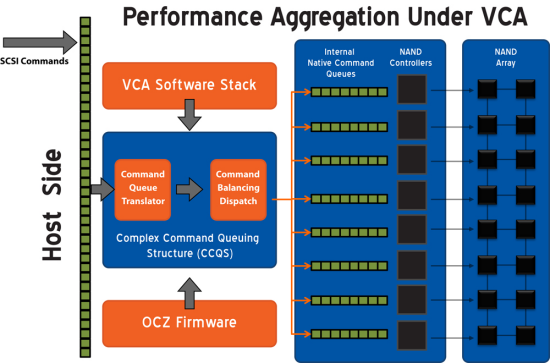OCZ's VCA 2.0 (Virtualized Controller Architecture) is the next step in the evolution of enterprise flash virtualization layers. This follow up to the original VCA presents as a complete storage subsystem, but with an improved and expanded feature-set allowing unprecedented flexibility and industry-leading performance and reliability. Along with TRIM, SCSI unmap and SMART monitoring suport, VCA 2.0 features user-selectable data recovery and non-stop modes for unprecedented data protection. Unlike other flash virtualization layers, it also offers complete power fail protection. In the event of unexpected system power loss, OCZ’s enterprise power fail protection completes all in-progress transactions, protecting the integrity of all active data.

The OCZ SuperScale storage controller combines processing and full DMA (direct memory access) cores, as well as internal PCIe, SATA and SAS interfaces. This controller, combined with VCA 2.0 provides unique benefits to users by allowing certain DMA and data management functions including OCZ’s unique command queuing and queue balance algorithms to be handled by the onboard processing core, resulting in higher performance and reduced burden on the host CPU.
In the enterprise PCIe implementation of VCA 2.0, users have the option of treating each SuperScale accelerator as one more Virtual Logical Drive (LUNs). Storage management software such as file systems, volume managers, and applications are able to access a number of LUNs allowing unprecedented flexibility in storage, while maintaining the hardware assisted features of VCA 2.0 and enabling the host to boot from the PCIe device.
VCA provides highly efficient performance aggregation across physical LUNs via an intelligent complex command queuing structure that utilizes both native and tagged command queuing (NCQ, TCQ). This is a unique technology that enables command switching and balancing based on OCZ’s proprietary Queue Balancing Algorithm (QBA) algorithm; this balances drive loading while maximizing internal bandwidth for nearly linear performance aggregation. VCA 2.0 LUNs can be further aggregated through cascading with host-side striping dependant on the storage architects needs. VCA is able to address NAND flash in an innovative way through the use of a massively parallel array, eliminating bottlenecks by increasing both read and write speeds up to the theoretical interface limit while keeping access latencies to a minimum.
Additionally, VCA 2.0 supports the industry standard SCSI command set over our PCIe interface. Because SCSI is the command set of choice of enterprise storage architects, this feature makes installation of OCZ PCIe devices in enterprise applications seamless. VCA technology can interpret and execute both SCSI and ATA commands across any physical interface and utilize any available internal interface to facilitate communication across multiple elements of the overall drive architecture. Current OCZ hardware implementations support SCSI commands over PCIe (Z-Drive) and Serial (Talos). This storage virtualization currently allows SCSI commands to be sent through PCIe or SAS physical interfaces to an internal virtualized array of NAND devices.

